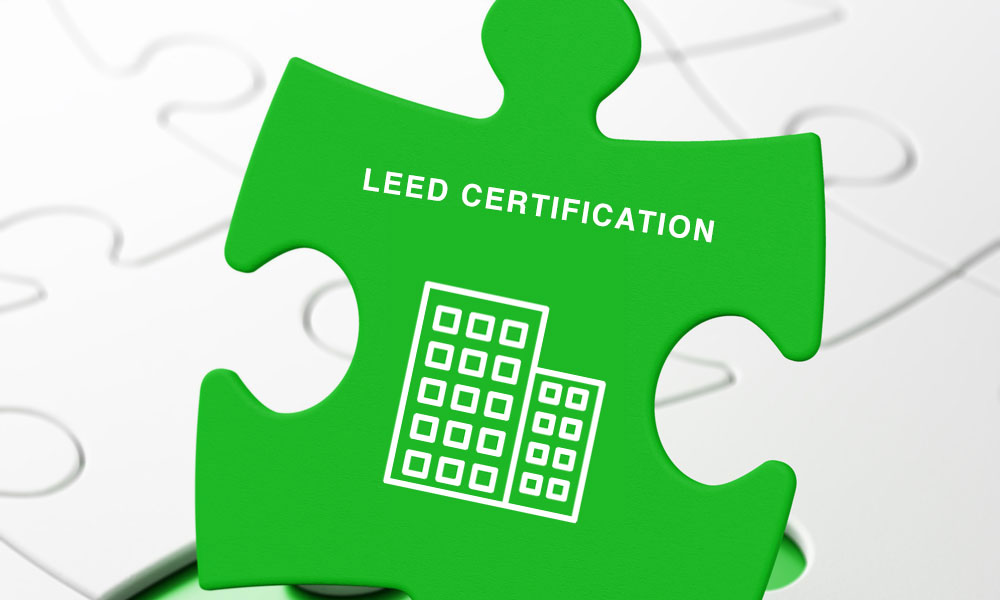Energy efficiency refers to the method of reducing consumption of energy to attain the same amount of useful output; what most of us would call do more with less. By reducing energy waste and controlling how energy is being used, buildings cost less to operate, produce fewer greenhouse gasses and improve the quality of our air, which helps to protect the entire ecosystem by using less of the earth’s natural resources.
Leadership in Energy and Environmental Design (LEED) Certification
LEED or Leadership in Energy and Environmental Design is a popular and internationally recognized green building certification program; Developed by the non-profit U.S. Green Building Council(USGBC). LEED certification provides independent, third-party verification that a building, home or community was designed and built using strategies aimed at achieving high performance in key areas of human and environmental health: location and transportation, sustainable site development, water savings, energy efficiency, materials selection and indoor environmental quality.
LEED-certified buildings present many tangible and intangible benefits that improve the owner's bottom line while promoting sustainability. Examples of these benefits are: faster lease-up rates, higher property values, eligibility for a host of incentives; like tax rebates, utility rebates, zoning allowances, tax credits, lower insurance premiums, etc.
The ultimate goal of LEED certification is to create green buildings with comprehensive benefits for everyone, it's occupants, it's owners and the community. The LEED certification standard of 2009 looks at: 100 possible base points distributed across six credit categories: Sustainability, Water Efficiency, Energy and Atmosphere, Materials and Resources, Indoor Environmental Quality, and Innovation in Design. Its mission is to help transform the way our communities are designed, built, and managed. It is estimated that by the end of 2020, LEED-certified buildings will have directly contributed almost $30 billion to the United States’ GDP.
LEED Requirements for Sub-Metering
Sub-metering is a critical component of LEED-certified buildings. Developers, property managers, and consultants want a cost-effective, end-to-end solution for achieving LEED credits.
As a prerequisite for certification, LEED requires building-level energy metering. Operators and owners must measure total building capacity and share detailed data with the USGBC (U.S. Green Building Council) or CAGBC (Canada Green Building Council.) Additionally, LEED takes building-level energy metering further by requiring meters to measure and record energy usage at one hour intervals or more frequently. This advanced prerequisite provides much more detailed data to building operators and owners regarding when and how energy is consumed. Adding sub-meters to new buildings and retrofitting existing buildings allows building owners to measure the consumption of electricity, water, and gas more accurately and in more detail; with more granular data building operators can make better decision on the allocation of consumption to drive efficiency.
With sub-meters installed, a building may be qualified for design innovation credit, and increase the overall LEED grade:
Energy Efficiency
Requirement – Building-level energy metering. Install the main utility electricity, thermal, gas, and/or steam meters. Use software for automated data collection, continuous operation monitoring, and for creating reports.
Credit – 1 point for building-level metering, 2 points for sub-metering.
Water Efficiency
Requirement – Building-level water metering. Install the main utility water meter and/or sub-meters. Use software for automated data collection, continuous operation monitoring, and for creating reports .
Credit – 1 point for building-level metering, 2 points for sub-metering.
Innovation Credits
Tenant energy engagement – By providing energy meter hardware and portal software for the tenants, you’ll show them their energy consumption, thus helping the property to engage tenants. That will allow them to know where and how energy is used inefficiently so they can take energy-reducing actions.
Energy awareness – By integrating with or deploying lobby sustainability dashboards, you’ll have a dashboard software and meter data that will show building-level energy use, building sustainability features, and allow for education programs.
Along with building-level metering, the analysis of trends and time for sub-metering also depends on uninterrupted data collection and periodic result summaries for each metered subsystem. The LEED v4 rating system comes with more rigorous standards. Some of the requirements and credits have stayed the same, but there are also some significant changes that should be addressed for getting LEED-certified.
Green building practices are an upward trend around the world, bringing a number of environmental and economic benefits. They eliminate or reduce negative impacts on the environment (using less energy, water, or natural resources). They also help reduce energy and construction costs, creating high property value for building owners and developers.


